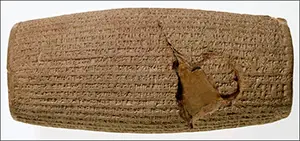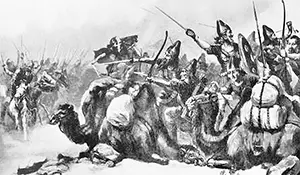Cyrus the Great: Founder of the Persian Empire
Cyrus the Great was the founder and perhaps the most famous of the leaders of the Persian Empire, which at one time was the world's largest. He was at turns a shrewd tactician, a magnanimous conqueror, and a benevolent ruler. He was not above exhibiting the cruelty of his times; he was not beneath allowing others to live, worship, and conduct business as they pleased. The Persians first rose to prominence as a client kingdom of the Median Empire. The Persians lived southeast of both Ecbatana, the Median capital, and the home of the Elamites, another ancient power. 
The maternal grandson of the Median king Astyages, Cyrus was the second of his name to be King of Persia. The first, Cyrus I, was the grandson of Achaemenes, founder of the Achaemenid dynasty. For this reason, when Cyrus took over most of the lands around him, he declared the Achaemenid Dynasty, tracing his lineage through his father, Cambyses I, and his father, Cyrus I, and his father, Teispes, back to his father, Achaemenes. Cyrus became king in 559 B.C. Within a decade, he had molded the rest of the tribes into a federation of sorts and set about conquering the lands around them. The Persian warriors eventually came into conflict with the Medes, and Cyrus defeated his own grandfather, the Median King Astyages, in 550 B.C. Cyrus's first capital was Ecbatana; he called it Pasagardae, after his homeland. Cyrus and his armies conquered not only the Medes but also the Lydians and the Babylonians. One of Cyrus's titles, in addition to the well-known "The Great King" and "King of Kings," was "King of the Four Corners of the World." The Lydian conquest featured the dual nature of Cyrus: He was willing to ignore the supposed rules of warfare, in more ways than one. After engaging the King Croesus and the Lydians in an autumn battle Babylon Cyrus conquered not by force but by nonviolent strategy. The king of Babylonia at the time, Nabonidus, was unpopular with his own people. Cyrus let it be known far and wide that he would certainly be the better choice as a ruler and that he would govern not as a conqueror, destroying the traditions of the conquered, but as a benevolent father figure, allowing the local people to continue their religious and other traditions as long as they revered him and paid tribute to him. It didn't help that Cyrus arrived in Babylon at the head of a large army after diverting the Euphrates River and using a national ceremony as cover for what turned out to be a peaceful occupation.fr Cyrus also was able to portray himself as magnanimous by allowing the captured Israelites return to their homeland and rebuild their temple in Jerusalem. This happened in 539 B.C. 
His name is part of the Cyrus Cylinder, which many historians consider to be the oldest surviving human rights charter. The text, which is in Akkadian cuneiform, was a pronouncement by Cyrus and stipulated terms of racial, linguistic, and religious equality. This kind of multiculturalism was a vision that Cyrus had for his empire, and it allowed the empire–with its variety of peoples, tongues, religions, and customs–to flourish in a way that previous polyglot patriarchies had not. When Cyrus died in 530 B.C., his empire stretched far and wide, from the borders of Egypt in the west to the Black Sea in the north, to the Indus River in the south. His successors would only enhance it.  |
|
Social Studies for Kids
copyright 2002–2024
David White



 near the Halys River, he refused to do as Croesus had done and ordered his troops home to wait through the winter and continue the fighting in the spring; Cyrus, rather, followed the Lydian troops back to their homeland and sacked Sardis, the Lydian capital. Rather than have Croesus killed, however, Cyrus spared his life so he could interrogate him about how best to govern the kingdom that had just switched hands. (This was not the first or the last time that Cyrus would do this sort of thing.)
near the Halys River, he refused to do as Croesus had done and ordered his troops home to wait through the winter and continue the fighting in the spring; Cyrus, rather, followed the Lydian troops back to their homeland and sacked Sardis, the Lydian capital. Rather than have Croesus killed, however, Cyrus spared his life so he could interrogate him about how best to govern the kingdom that had just switched hands. (This was not the first or the last time that Cyrus would do this sort of thing.)
